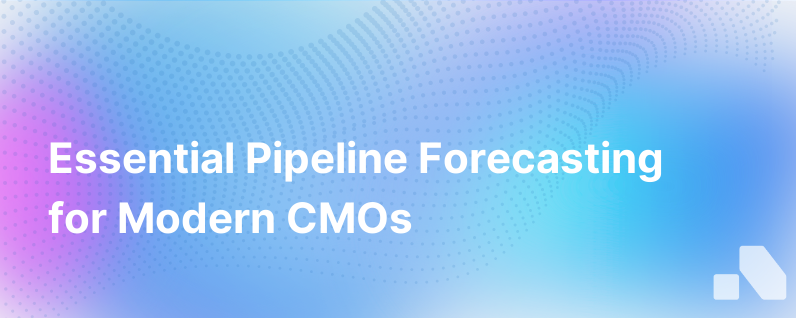
In the ever-evolving terrain of modern marketing, chief marketing officers (CMOs) grapple with an array of responsibilities, from brand stewardship to driving growth strategies. Among the toolkit essentials for any high-performing CMO is a robust pipeline forecast. Far from a mere projection of sales, it's an analytical framework that informs strategic decision-making, resource allocation, and ultimately, the success of marketing initiatives.
The Critical Role of Pipeline Forecasting
A pipeline forecast serves as a navigational instrument, guiding CMOs through the fog of market unpredictability with data-led insights. This real-time barometer of future business health delivers invaluable intel for modern CMOs who need to anticipate market shifts, optimize conversions, and justify marketing spend with clear ROI. It's a fusion of science and insight that transforms raw data into strategic foresight.
Predictive Analytics Empowers Proactivity
Understanding customer behavior and predicting future trends are key competencies for today's CMO. The pivot from reactive to proactive marketing is anchored in effective forecasting. Utilizing predictive analytics, CMOs can foresee changes in customer demand, adapt campaign tactics swiftly, and stay ahead of market trends.
Alignment Across Sales and Marketing
Sales forecasts have long been integral to the modus operandi of sales teams, but the modern CMO recognizes that marketing plays a critical role in feeding the top of the sales funnel. A pipeline forecast is a nexus that aligns marketing initiatives with sales outcomes, fostering a symbiotic relationship that ensures both teams are marching to the beat of a unified strategic drum.
Building the Framework for a Robust Pipeline Forecast
While the principle of pipeline forecasting is straightforward, its execution is far from simple. It requires a blend of data sophistication, technological acumen, and strategic vision. Here's how modern CMOs can craft a pipeline forecast that not only projects potential revenue but also powers the strategic engine of their marketing machinery.
1. Data Integration and Quality
The bedrock of any accurate forecast is data, but not just any data – high-quality, integrated data. CMOs must consolidate information across multiple platforms, from CRM tools to marketing automation systems, to weave a coherent narrative. Clean, accurate, and comprehensive data sets are imperative to avoid the perils of misinformed decisions.
2. Customer Journey Analytics
Understanding the paths that prospects take from awareness to conversion enables CMOs to model forecasts that resonate with reality. Deep dive into customer journey analytics to discern patterns, identify chokepoints, and ascertain the efficacy of marketing touchpoints.
3. Machine Learning and AI
Artificial Intelligence (AI) and Machine Learning (ML) elevate forecasting from educated guesswork to algorithmically precise prognostications. Leveraging AI tools can help decipher complex datasets, glean insights, and project future trends with a degree of accuracy beyond human conjecture.
4. Scenario Planning and Simulations
The volatility of modern markets demands a multi-faceted view of the future. Scenario planning and simulations allow CMOs to test different assumptions and external influences, gaining a clear-eyed view of potential outcomes and preparing contingency strategies.
The Strategic Payoffs of Pipeline Forecasting
The dividends of a pipeline forecast extend across the strategic spectrum of a CMO's domain.
Optimizing Marketing Spend
CMOs are constantly under scrutiny to deliver ROI from their marketing budgets. A clear pipeline forecast allows for strategic allocation of spend, channeling resources into campaigns and channels that demonstrably drive pipeline growth.
Personalization at Scale
By anticipating customer needs and behaviors, CMOs can tailor communications and interactions to align with customer expectations. Personalized marketing, underpinned by predictive insights, yields higher engagement and conversion rates.
Revenue Impact and Growth Planning
Ultimately, the litmus test for any marketing initiative is its impact on revenue. Pipeline forecasting not only projects revenue impact but also informs growth planning, identifying areas of opportunity and guiding market expansion strategies.
Risk Mitigation
In uncertain economic climates, the ability to anticipate downturns and adjust course rapidly is not just advantageous – it's a survival imperative. A dynamic pipeline forecast serves as an early warning system, allowing CMOs to mitigate risks and protect business continuity.
Closing Thoughts with a Nod to Aomni
Pipeline forecasting isn't a crystal ball that offers unerring clairvoyance, but it's an indispensable strategic asset for modern CMOs. It is a confluence of data science, technology, and strategic marketing that allows them to steer their organization with confidence amidst the unpredictable currents of modern commerce.
For CMOs seeking to harness the power of pipeline forecasting, Aomni provides a seamless, AI-driven platform that simplifies the process. It streamlines real-time account research, competitive insights, and sales content generation – all tailored to empower strategic decision-making without demanding excessive effort.
Positioning pipeline forecasting as a cornerstone of your marketing strategy is not just advantageous; in today's fast-paced business world, it is a categorical imperative. With the right approach, tools, and mindset, it's a practice that can redefine the trajectory of your strategic marketing outcomes, laying the foundation for sustained success.